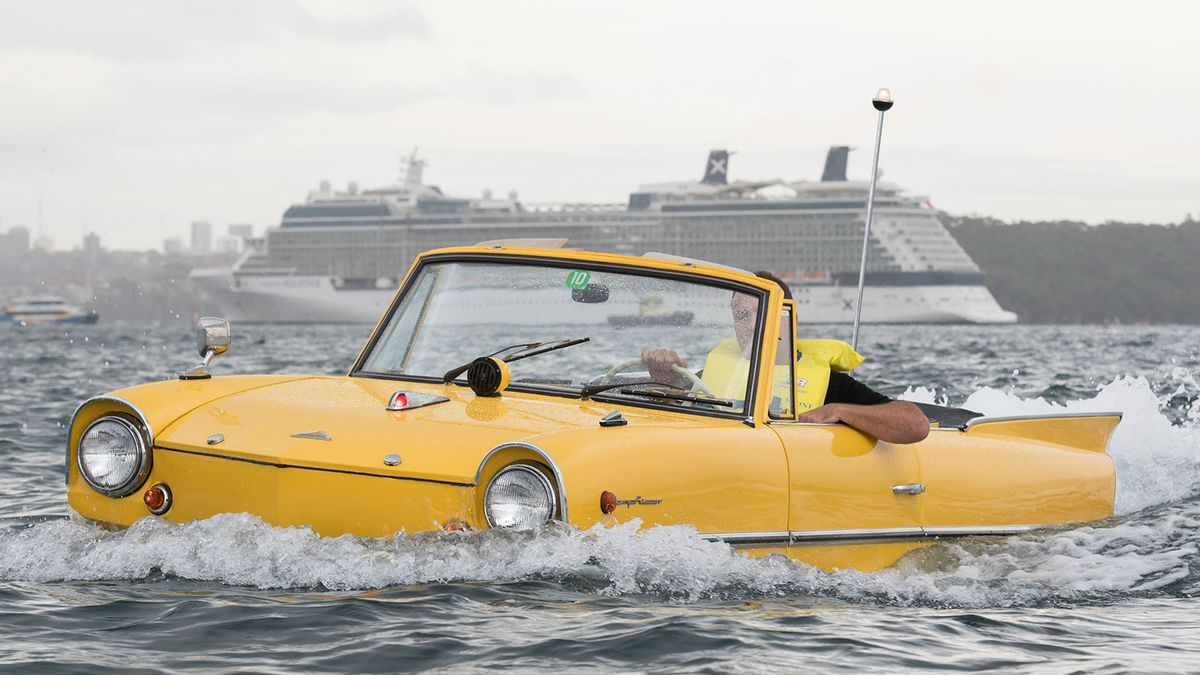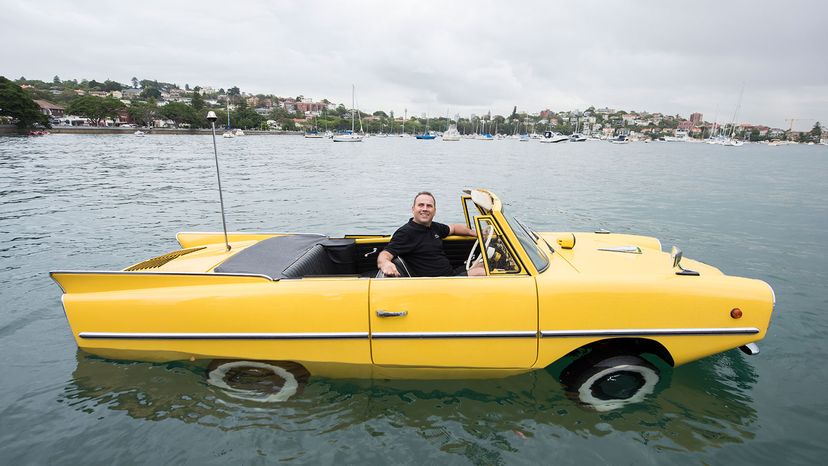

In 1962, Trippel launched the most sensational promotional ploy of his career by sending an Amphicar from France to Britain across the often-turbulent English Channel. This stunt was successful, and it naturally captured the attention of both car and boating enthusiasts all over the world.
Officially designated Model 770, the Amphicar was built only as a two-door four-seat convertible with a folding cloth top. Its engine was the 1147cc (70-cid) overhead-valve inline four from the British Triumph Herald, but relocated astern to drive the rear wheels and/or a pair of propellers.
Wheelbase was a diminutive 82.67 inches, which is more than a foot shorter overall than the 170.3-inch-long Amphicar. Overall width was 60.3 inches, about the norm for a small early-’60s European, but track dimensions were fairly narrow at 47.3/49.2 inches front/rear.
The aft engine mounting means the trunk is up front under the “hood.” A compartment behind the rear seat backrest offers a small amount of additional stowage space alongside the top and its folding supports.
Amphicar’s successful English Channel crossing generated a lot of interest in America, which would take nearly 80 percent of the amphibian’s total production, some 3,000 units.
Though often described as “chassis-less,” the Amphicar’s body/hull employs a box-section steel sub-frame for added torsional strength, made up of parallel longitudinal members and five cross-members. Strong mountings are used for the fully independent suspension, and all sub-frame components and the steel body panels are arc-welded.
The owner’s manual specifically warns against the use of gas welding for structural repairs because of the possible metal deformation and resulting water leaks it can cause. Considering the Amphicar’s seaworthiness, it’s a bit surprising Trippel didn’t elect to make the body/hull in no-rust fiberglass instead of steel.
However, he did specify metal of unusually heavy gauge. Side panels are .028, wheel arches .039, and hull bottom panels are .049. Greater thoughtfulness is evident in the design of the Amphicar doors and their absolutely watertight seals. There’s a seal on each door that mates with a separate one on the door frame.
Once a door is closed and securely latched, a second tongue-type lock compresses the seals together and prevents the door from being opened accidentally. Each door has double hinges topped with rubber plugs.
The Amphicar’s up-front luggage compartment is divided into three sections. The middle one houses the spare wheel and tire, and this secluded cavity should be checked frequently for leaks. Astern is a 70-watt electric bilge pump secured to the engine firewall. It has two hose connections and a capacity of just 6 gallons per minute.
Frequent hull inspections at panel seams and joints are essential. Also recommended after cruising in salt or brackish water is a thorough hosing with fresh water for the entire hull and all exposed suspension and nautical propulson components.
Because of the Herald engine, any Amphicar owner would also do well to join a Triumph owners club. However, accessibility is excellent, maintenance and repairs comparatively simple, and parts are still readily available and reasonably priced.
It’s a gutty little engine that made the Herald a satisfactory all-round performer and moderately quick in city driving, but 43 horsepower and 50 pounds-feet torque can’t move mountains and, at almost 2,300 pounds, the Amphicar is some 526 pounds heavier at the curb.
Low-end acceleration is thus leisurely despite the four-speed manual gearbox-built by Porsche, no less-with floor-mount shifter and synchromesh on all gears except first. However, the Amphicar will climb a maximum gradient of 42 percent, so it’s something of a mountain goat, too.
With its tall build (overall height is nearly 5 feet with the top up) and generous 11.2-inch ground clearance, the Amphicar can enter or leave the water at rather steep angles, and can even be backed into the drink if marina launching space is overly narrow.
The twin three-blade screws measure a foot in diameter. Drive is taken through a separate water transmission controlled by a simple transfer lever with forward and reverse positions, located next to the conventional gearshift on the center console.
Engine torque is carried from the crankshaft over the plate clutch to the transmission shaft, then to the main shaft and a hypoid differential. The water transmission’s gears run on ball and needle bearings, versus needle bearings only for the roadgoing gearbox. Clutch adjustment, with correct free play, is particularly important because of the “dual environment” transmissions.
Perhaps surprisingly, the Amphicar has no rudder. The front wheels take care of nautical navigation, which takes a bit of familiarization.








